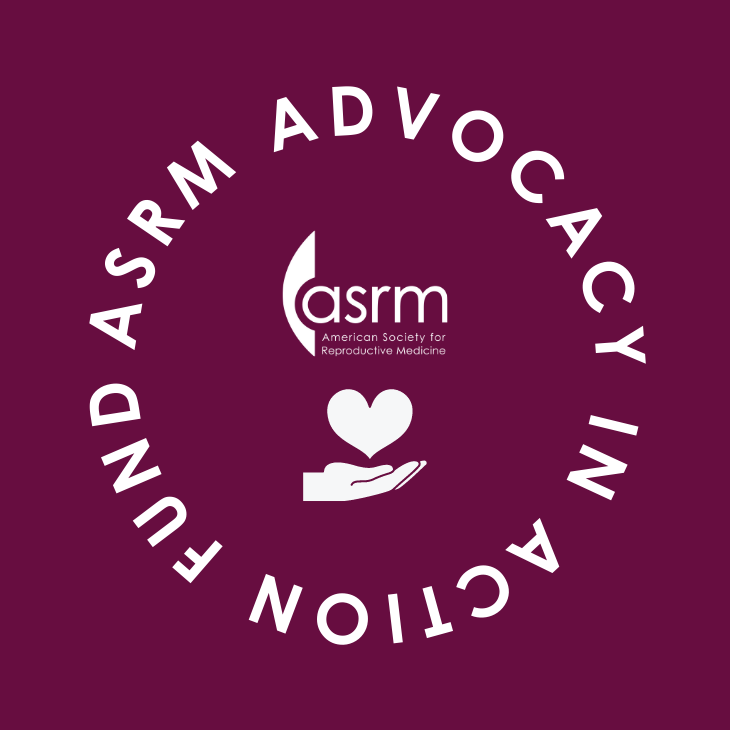
Questions and Key Recommendations for Implementation
Introduction
On October 16, 2025, the Trump Administration announced a two-part initiative on in-vitro fertilization (IVF), focused on reducing the cost of select IVF drugs and clarifying options for employers to offer standalone fertility benefits to employees, like existing methods of offering dental and vision coverage.
This paper highlights- How the Trump Administration’s initiative meets the current landscape of access to reproductive and fertility care,
- Key details of the Trump Administration’s initiative, including a comprehensive explanation of ‘excepted benefits,’
- Unresolved questions regarding development and implementation of insurance guidance,
- How this initiative should be evaluated by key stakeholders and the general public, and
- Guidance and recommendations from the American Society for Reproductive Medicine (ASRM) Center for Policy and Leadership (CPL) for equitable access to fertility and reproductive health care.
State of Access to Reproductive and Fertility Health Care
Infertility affects individuals in the United States across all gender, racial, and ethnic identities. Approximately one in six adults experience infertility during their lifetime, and one in eight women of reproductive age report that they or their partner required fertility services.(1,2)
Despite the prevalence of infertility, access to fertility care remains limited, with cost identified as the most significant barrier. Among individuals who needed fertility services but did not obtain them, 12% cited expense as the primary reason (1). Financial barriers are even more pronounced among lower-income populations, with nearly one-quarter reporting cost as the prohibitive factor (1). While assisted reproductive technologies (ART), including in-vitro fertilization (IVF), have existed for decades, legal, financial, and discriminatory barriers to these treatment options persist. As a result, many Americans are unable to access this critical component of health care.
Many private employer plans do not classify fertility treatments as medically necessary, and public programs, like Medicaid and Medicare, generally exclude coverage for IVF and related services (1). State mandates for infertility coverage exist in some states but vary significantly in their scope, and often exclude single individuals or same-sex couples (3). Regional, income, racial and insurance status disparities further hinder access to fertility care, compounding issues of reproductive justice and health equity (4).
ASRM emphasizes that fertility treatment, including IVF, is an essential component of reproductive health care, not a discretionary family policy benefit. Framing access to ART in this way aligns with broader public health concerns about declining fertility rates and barriers to family formation.
Key Details of the White House Announcement
IVF Drug Pricing
The Trump Administration's IVF initiative contains two key components. The first, a drug pricing agreement with the pharmaceutical company EMD Serono, provides discounts on the list prices of select IVF-medications like Gonal-f, Ovidrel, and Cetrotide. These select medications will be offered at lower cost to eligible users through a government-operated portal, TrumpRx.gov. The agreement claims to match newly proposed domestic pricing to the lowest prices paid in a specified group of developed countries (Most-Favored-Nation (MFN) prescription drug pricing). Preliminary federal estimates from the Centers for Medicare and Medicaid Services (CMS) suggest potential savings of up to $2,200 per treatment cycle for medications alone (5). This discount applies to a narrow subset of drugs within the broader IVF regimen, which can cost tens of thousands of dollars per cycle and involve multiple drugs beyond those listed. The portal is expected to be operational by 2026 (5).
Fertility Benefits
The second component authorizes, but does not require, private employers to offer fertility benefits as ‘excepted benefits’ like dental and vision coverage. This kind of benefit is excluded from many federal consumer protections. This component of the initiative clarifies that employers may voluntarily offer fertility‑care benefits as excepted benefits under existing federal law through two models:
- A standalone insured fertility benefit operating independently from an employers’ major medical plan, and
- A limited Health Reimbursement Arrangement (HRA) that reimburses out‑of‑pocket fertility expenses, capped at $2,150 annually (5).
In effect, the administration affirms that fertility benefits may be offered outside a primary health‑plan without triggering all major‑medical plan requirements. However, these options are voluntary and not accompanied by any federal mandate, subsidy, or tax credit.
Key implementation details for both of these initiatives have not yet been released. The specifics of the drug pricing discounts and where and when they will be available to patients remain unclear. Under the Administrative Procedures Act (APA), the second component of the initiative requires executive agencies like the Department of Health and Human Services (HHS), the Department of Labor (DOL), and the Department of Treasury to post a proposed rule and conduct an official notice and comment period prior to finalizing any rule or guidance governing how employers may offer fertility benefits to employees. Oversight of this process, and the final rule itself, will be critical in assessing the scope and impact of these policies on access to fertility care, including which populations ultimately benefit.
Early indications suggest that the policy language may allow employers broad discretion to design benefits aligned with religious or ideological value systems, with minimal accountability to consumer protection standards, so the policies may vary considerably.
Understanding Employer-Offered and ‘Excepted’ Benefits
Under the Health Insurance Portability and Accountability Act (HIPAA) and Affordable Care Act (ACA) frameworks, certain benefits, like dental, vision, specified disease, may qualify as excepted benefits, meaning they are not subject to the full spectrum of federal statutes regulating standard insurance plans.
In simple terms, excepted benefits are benefits that sit separate from a person’s main health insurance plan, which makes them easier for employers to offer but also more limited in what they can cover. Additionally, because these benefits sit outside the main health plan, they are exempt from many consumer protections, including essential health benefits requirements, mental health parity rules, and annual out-of-pocket maximums (6).
The Trump Administration’s initiative does not create a new category of benefits. Rather, it clarifies how existing benefits can be structured, explicitly confirming that employers may offer fertility coverage under the two recognized forms of excepted benefits. This mechanism allows employers to determine the contribution level for fertility services without a federally imposed spending cap. Under the Administration’s initiative, fertility treatment and IVF coverage could similarly be offered through two types of excepted benefits as:
- Independent, Non-Coordinated Excepted Benefits, and
- Limited Excepted Benefits via Health Reimbursement Arrangements (HRAs).
Independent, Non-Coordinated Excepted Benefits
The first type of excepted benefit allows employers to offer a standalone fertility benefit, such as coverage for infertility treatment under a separate insurance policy, that exists entirely outside the employee’s primary health plan. According to guidance from the DOL, employers may now offer standalone fertility benefits under this framework, even if they do not offer a traditional group health plan (7). However, self-funded arrangements are currently not permitted under this category, and benefits must be fully insured. While this model allows employers flexibility, a freestanding fertility benefit has a limited impact for those without broader coverage for pregnancy or prenatal care.
Limited Excepted Benefits
The second type of excepted benefit, a limited excepted benefit, allows employers to provide a capped contribution, $2,150 for 2025, that employees can use to cover out-of-pocket fertility expenses such as medications, lab work, or related services. While these HRAs can ease some financial burden, they are far below the full cost of an IVF cycle, making them a supplemental rather than comprehensive benefit. The cost of IVF remains a significant barrier to infertility care in the U.S., with the estimated cost of a single cycle, defined as ovarian stimulation, egg retrieval, and embryo transfer, ranging from $15,000 to $20,000 (8). To qualify as a limited excepted benefit, the HRA
- Must be separate from an employer’s primary health insurance plan,
- Cannot reimburse premiums for major medical coverage, and
- Must be uniformly available to all similarly situated employees.
Employers may also use a limited excepted benefit structure for Employee Assistance Programs (EAPs) that provide fertility coaching, navigation, or counseling. However, an EAP cannot cover medical services such as IVF procedures if it wishes to remain a limited excepted benefit. (7)
Implications for the White House Initiative
While limited excepted benefits give employers a manageable way to support fertility care without triggering major insurance requirements, their financial scope is limited, and they do not provide or replace comprehensive fertility coverage.
Though the clarifying guidance from the White House may increase employer flexibility, coverage pathways are voluntary, meaning employers may choose to offer them but are under no obligation to do so, and employees are not guaranteed access to fertility care under this framework. This leaves open questions about whether lower-income workers, those with self-insured plans, or historically underserved populations will actually gain meaningful access to fertility care.
It is also important to note that the Trump Administration’s Executive Order on expanding access to IVF sets a policy direction, but it does not itself create binding regulation. Executive actions outline priorities, while agencies determine what can legally be implemented based on their statutory authority under the Employee Retirement Income Security Act (ERISA), the ACA, and the Internal Revenue Code (IRC). As a result, not all directives in the Executive Order will necessarily produce binding rules, and final policies will depend on agency interpretation and the rulemaking process.
Excepted Benefit Models Table Comparison
| Feature | Independent Excepted Benefit | Limited Excepted Benefit |
| Structure | Standalone Insurance Policy | Employer-funded Reimbursement |
| Coverage Scope | Infertility Treatment | Out-of-Pocket Fertility Expenses |
| Annual Financial Cap | None (fully insured) | $2,150 for 2025 |
| Eligibility | Employed Personnel Only | Employed Personnel Only |
| Limitations | No Major Medical Coverage | Provides a limited discount does not cover the cost of an IVF cycle |
Outstanding Questions, Practical Considerations, and Regulatory Oversight
Equity and Access
A central question is whether the Trump Administration’s IVF initiatives will improve fertility care for historically underserved populations. This includes low-income individuals, Medicaid beneficiaries, people in rural communities, and LGBTQIA+ individuals. Current research shows that these groups face substantial barriers to fertility services, including lack of insurance coverage and limited geographic access to clinics. (9)
Disparities in access to fertility care reflect broader inequities in the health care system. Empirical research shows persistent disparities in referral rates, access to treatment, and IVF success rates among Black, Hispanic, and low-income patients, even when controlling for clinical factors. (9,10)
The ASRM Center for Policy and Leadership (CPL) recommends close attention to how the initiative tracks and reports on equity outcomes. Without clear mechanisms for data collection and monitoring, there is a risk that disparities in access and success rates could persist or even widen.
Benefit Design and Coverage Enforcement
Another key consideration is the design of benefits that will be offered under the Trump Administration’s initiative. The initiative’s drug pricing deal covers only select medications, not full cycles, embryo storage or multiple transfers. In addition, employer benefit design under “excepted benefits” may vary widely, and many workers are covered by self-insured plans exempt from state fertility mandates. Due to the lack of oversight and accountability for designing excepted benefit plans, questions remain about whether benefits will cover multiple cycles or be inclusive of family structures such as single individuals or same-sex couples.
Regulatory Implementation and Oversight
Effective implementation requires clear rules, guidance, and agency coordination. DOL provides guidance on excepted benefits and oversees rule-making processes. HHS oversees insurance regulation, potential inclusion of fertility treatments in essential health benefits, and data collection for access and outcome tracking. Treasury manages tax implications and ensures alignment with employer health plan requirements.
Agencies must clarify key definitions, including “fertility benefits,” and outline reporting, compliance, and enforcement mechanisms, and the timelines for doing so are unclear. Monitoring adoption and uptake is critical, particularly given variability in state mandates and employer types. Agencies also need to address potential cost impacts for employers, insurers, and employees and ensure clear communication to facilitate enrollment and navigation.
Structural Implementation Concerns
After taking this first step in addressing barriers to fertility care, will the Trump Administration acknowledge and address broader, long-term challenges, such as the full cost of IVF beyond medications, provider capacity, regional disparities, and insurance plan design? How will agencies ensure that provider networks are sufficient, that patients receive high-quality care, and that outcomes, such as live birth rates, are tracked?
Structural gaps also persist: the full cost of IVF includes more than medications, and many employer-offered benefits may not cover all necessary procedures or cycles. Regional disparities in provider availability, insurance design limitations, and financial barriers must be addressed to ensure meaningful access.
Policy Priorities, Recommendations, and Evaluation
The ASRM Center for Policy and Leadership (CPL) recommends the following priorities to ensure comprehensive and equitable access to fertility and reproductive health care:
Access and Affordability
Fertility treatments should be affordable and accessible to all eligible individuals, without undue financial burden.
Equity and Inclusivity
Benefits should include single individuals, same-sex couples, diverse racial and ethnic groups, and low-income populations.
Comprehensive Continuum of Care
Coverage should extend beyond medications to diagnostics, lab work, embryo storage, multiple cycles, and follow-up care.
Quality and Transparency
Benefits should link to high-quality fertility care, with outcome tracking, informed consent, success rate monitoring, and safety oversight.
Regulatory Clarity
The development of regulatory guidance and any rulemakings should align, as much as possible, across federal, state, and employer frameworks to minimize ambiguity and maximize consistent implementation.
Long-Term Sustainability
Expanded access should be designed with actuarial soundness and efficiency to prevent unsustainable costs.
Data and Evaluation
Agencies should collect robust data on uptake, coverage, utilization, costs, and outcomes to inform ongoing policy refinement.
Recommendations for Implementation
Utilizing this policy priority framework, the CPL proposes the following recommendations for effective, equitable, and timely implementation of proposed policies:
- Short-term recommendations include issuing preliminary guidance on coverage scope under excepted benefit categories, clarifying drug-pricing agreement details, providing model benefit templates for employers, and promoting outreach to patients and employees.
- Medium-term actions involve issuing updated regulations to expand fertility benefit options, integrating coverage into Medicaid and other programs, encouraging state-level mandates, and monitoring cost impacts.
- Long-term strategies should include mandating fertility treatments as essential health benefits, ensuring continuous evaluation of equity outcomes, and integrating fertility access with broader maternal and family health policies.
Evaluation Metrics
Evaluation of the Trump Administration’s IVF initiatives should assess adoption rates of standalone fertility benefits, inclusion of diverse populations under employer-designed plans, reduction in patient financial burden, improvement in access and outcomes, cost sustainability, and any unintended consequences such as minimal coverage or limited networks. Agency adherence to guidance, regulations and transparency will also be critical to ensuring meaningful and equitable improvements in fertility care.
References
- Ranji, U., Diep, K., Frederiksen, B., Gomez, I., & Salganicoff, A. (2024, October 21). Access to Fertility Care: Findings from the 2024 KFF Women’s Health Survey. KFF.
- World Health Organization. (2023, April 4). 1 in 6 People Globally Affected By Infertility. WHO.
- RESOLVE: The National Infertility Association. (n.d.). Insurance Coverage By State. RESOLVE.
- Kawwass, J. F., Penzias, A. S., & Adashi, E. Y. (2021). Fertility—A Human Right Worthy of Mandated Insurance Coverage: The Evolution, Limitations, and Future of Access to Care. Fertility and Sterility, 115(1), 29–42.
- The White House. (2025, October 16). Fact Sheet: President Donald J. Trump Announces Actions to Lower Costs and Expand Access to in vitro fertilization (IVF) and High-Quality Fertility Care. The White House.
- U.S. Department of the Treasury; U.S. Department of Labor; U.S. Department of Health and Human Services. (2024). Final Rules for Excepted Benefits (89 Fed. Reg. 6551).
- 7.U.S. Department of Labor. (2025, October 16). FAQs about Affordable Care Act implementation Part 72. DOL.
- U.S. Department of Health & Human Services. (2024, March 13). Fact Sheet: In vitro fertilization (IVF) Use Across the United States. HHS.
- Ethics Committee of the American Society for Reproductive Medicine. (2021). Disparities in Access to Effective Treatment for Infertility in the United States: An Ethics Committee Opinion. Fertility and Sterility, 116(1), 54–63.
- Merkison, J. M., Chada, A. R., Marsidi, A. M., & Spencer, J. B. (2023). Racial and Ethnic Disparities in Assisted Reproductive Technology: A Systematic Review. Fertility and Sterility, 119(3), 341–347.
Acknowledgements
This research was led by ASRM Center for Policy and Leadership Associate, Amelia Letson with support from ASRM Center for Policy and Leadership Director, Rebecca W. O’Connor, J.D., ASRM Chief Policy and Advocacy Officer Sean Tipton, M.A, Georgette Kerr, and additional legal analysis support from Hogan Lovells US LLP.
About the ASRM Center for Policy & Leadership


Please contact cpl@asrm.org for inquiries about this report.

Evaluating the Trump Administration’s Initiative on IVF
Analysis of Trump’s IVF initiative by ASRM with key policy insights, cost implications, and equity concerns in fertility care access.
Key Details & Emerging Questions from the White House's IVF Announcement
White House IVF initiative offers deep discounts on fertility drugs and new employer‑benefit pathways, though full coverage and equity gaps remain.
Follow the Science: An Evidence-Based, Science-Driven Response to Infertility
A science-based infertility evaluation and treatment guide, grounded in clinical best practices, counters ideologically driven alternatives like RRM.Topic Resources

The ASRM Center For Policy And Leadership
The ASRM Center for Policy and Leadership (CPL), established in 2020, builds on ASRM’s longstanding role as a leading policy voice on Capitol Hill and in state capitals.
Get Involved



